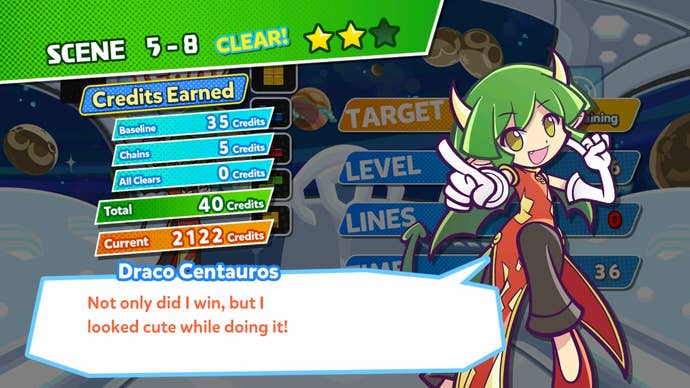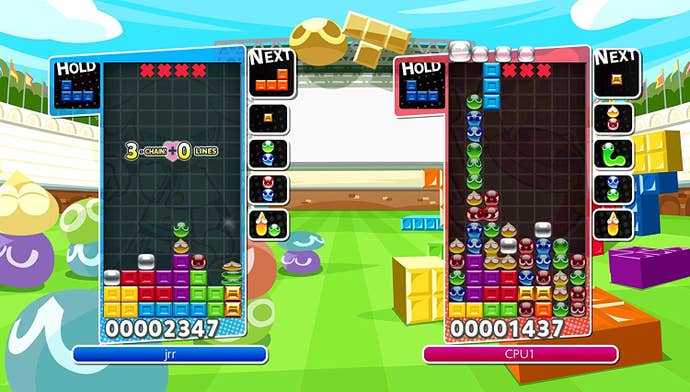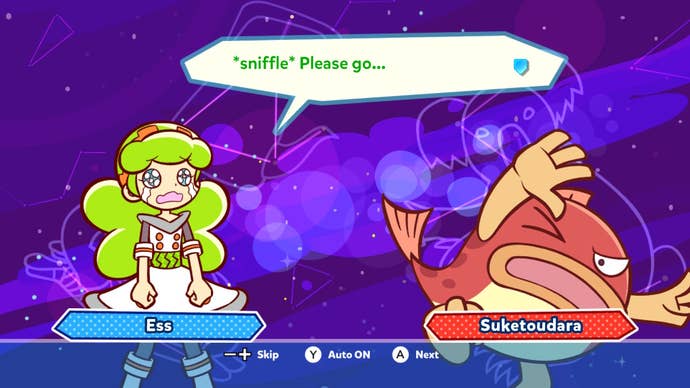Puyo Puyo Tetris Review
Can Tetris and Puyo Puyo live in perfect harmony?
This article first appeared on USgamer, a partner publication of VG247. Some content, such as this article, has been migrated to VG247 for posterity after USgamer's closure - but it has not been edited or further vetted by the VG247 team.
It feels like everytime I try to rest nowadays, a rainfall of the blobs and blocks of Puyo Puyo Tetris dance across my closed eyelids. That's probably because I’ve spent the past few weeks with the ever-dropping Puyos and Tetriminos.
I’ve made a habit of playing the game nightly from the comfort of my bed. Without fail, the game would keep my eyes glued, making me always end up staying awake far past my alarm-regulated bedtime. Whether I'd waste late hours poking at its surprisingly lengthy Adventure mode (which amounts to nothing more than fluff and character unlocks, as expected), or battling against my partner in one of its many arcade modes, my time with Puyo Puyo Tetris was always varied. Sometimes for the better, sometimes less so.
There have been better Puyo Puyos (Puyo Puyo 2). There have been better Tetrises (Tetris DS). Nonetheless, Puyo Puyo Tetris is still a game that exists, and has actually already been around for three years overseas. Now it’s here in the West at last, with a PlayStation 4 and Nintendo Switch version in its saddle.
On the surface, Puyo Puyo and Tetris look the same, both utilizing similar vertical playgrounds. But their strategies couldn’t be more different. Tetris is a game of clearing lines through the blocks laid out. Puyo Puyo relies more on foresight, towering your Puyo blobs into a series of grouped twos and threes, before chaining up multiple chains-of-four to send it all towering downwards—thus spelling doom for your opponent. And that’s how a player finds success in Puyo Puyo Tetris: clearing multiple lines at once or chaining multiple Puyos in a row builds up an offensive attack on an opponent, sending a wave of silver rocks to inconvenience their progression.

Puyo Puyo Tetris has a lot, too. From the Start Menu, you have the option to hop straight into a plain ol' Puyo Puyo match, a plain ol' Tetris match, a Fusion match (which combines both simultaneously), or just click the handy Main Menu to see everything else the game has to offer. There’s three modes from there: Adventure, Solo Arcade, and Multiplayer Arcade. Adventure is straight-forward: working through a story mode, meeting characters like Tee (a humanized T-shaped Tetrimino, basically) and Witch (a Puyo Puyo character that looks like—yup!—a witch) along a journey through space and beyond, wielding Tetriminos and Puyos through each refined battle.

In Arcade Mode, both solo and multiplayer, there are six particular types of battling: Versus (choosing your poison before battle: Puyos or Tetriminos), Fusion (a combination of Tetris and Puyo Puyo in the same field), Party (where cleared items obstruct your nemesis in different ways, such as speeding up time), Challenge (a challenging six different modes in a row), Big Bang (where preset Tetrimino or Puyo patterns await you, and you clear them as fast as you can), and finally, my personal favorite mode, Swap. In Swap, the player musters through two games simultaneously: a Puyo Puyo match and a Tetris match. The maps shift back and forth between the other every 25 seconds, and as your maps build, the game grows increasingly tense with each swap. One slip-up, and it could spell the end.
Not every mode in Puyo Puyo Tetris is a rousing success though. Some modes—like Fusion and Big Bang—feel tedious and not as frenetically quick-witted as the others. In Swap, I had to be agile and constantly be aware of my maps' structures. In Fusion, the mixture of Puyos and Tetriminos operating in the same space just makes for a cluttered, frustrating experience. Big Bang, while fun for a match or two, only works on the pretense of its repetition. And once that’s been seen, it loses its fast-paced feverish joy, and becomes the most boring of all the modes.

There are 24 characters in total to unlock in Puyo Puyo Tetris. Their likenesses are familiar to any of the Puyo Puyo games, or wholly original ideas of what a sentient human (or even dog) shaped Tetrimino block might be. The Adventure mode’s story is endearingly outlandish, as the world of Tetris (complete with a holy Tetris King) and Puyo Puyo are cataclysmically combined. Over the ten chapter quest, with ten "stages" per chapter (which consist of miscellaneous battles against a CPU or a timer), the Adventure mode far outstays its welcome. But it's also not really bothersome, as the cutscenes are entirely skippable if the player so chooses. The battles per stage are varied enough to retain interest beyond its bland story.
Despite some modes being lesser than others, it doesn't change the fact that Puyo Puyo is timeless. Tetris is timeless. And while this isn't a perfect blend of the two methodically similar games (especially in the mode where its embedded concept should sing: Fusion), it sure gets close. It doesn’t change the fact that Puyo Puyo was always a game best played with friends; battling others to the bitter end. I imagine I’ll be hopping back into Swap mode whenever a friend visits, only to destroy them at the Puyo Puyo portion (and them destroy me at my weakness: Tetris). And I can't wait to strain all my friendships through it. As the adorable yellow marshmallow-cloud-creature-thing O might say, "Pi-pi-pi-pi-pi!" (which roughly translates to: "hey, this game is all right!").
Lasting AppealWith a variety of Adventure, Solo Arcade, Local and Online Multiplayer Arcade, there's plenty of Puyo Puyo and Tetris to fill time.
SoundEven if I grew tired of some characters' in-game call-outs over time, the music is bubbly, cute, with more to unlock in Adventure Mode.
VisualsThe character designs are adorable, as expected from the Puyo Puyo namesake. Also, in Adventure Mode players can unlock different skins for their Puyos and Tetriminos, adding a layer of customization.
ConclusionWhile not the best game in either series, Puyo Puyo Tetris is still a great combination of two puzzle classics. Sometimes going together like peanut butter and jelly, other times more like peanut butter, and uh, something that doesn't go with peanut butter. All in all, a worthwhile addition to the slowly growing Switch library (or PS4 library, if spontaneous on-the-go multiplayer is not your jam).

